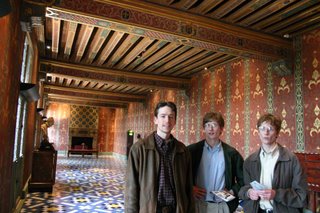Faith Seeking Understanding for April 30, 2006
The month of May – known as “Mary’s Month” – begins tomorrow, not with a feast of our Blessed Mother, but with the great feast of
After the Fall, however, as punishment for Original Sin, toil and sweat become elements of work, reminding us of the struggle that now exists in all creation, until Christ shall restore all things in Himself at the end of time (cf. Genesis 3:17-29). Nevertheless, work, just compensation, and care for the poor, all speak strongly of human dignity, and of our ultimate destiny of Eternal Rest in the Father’s house. While we toil, however, we pray to St. Joseph, patron of workers, to intercede for all laborers, that they would receive just wages for a just day’s work; and we are likewise reminded of our cooperation in the renewal of creation by the work of our hands, in imitation of St. Joseph, and of his foster son, our Lord Jesus Christ.
Throughout this month of May, we are also encouraged to grow in our devotion to the sinless spouse of
During this Eastertide, as we continue to celebrate the joy of the Risen Lord, the traditional Angelus prayer, recited at morning, noon, and evening, is replaced by the Regina Cæli (Queen of Heaven). We help sanctify the hours of our days when we stop to pray at specific times, or when prayer brackets our day. Honoring the Mother of God with this beautiful prayer recalls the union of her suffering with her Son on the Cross, and likewise the glorious triumph of the Resurrection.
Quia quem meruisti portare, alleluia.
Resurrexit sicut dixit, alleluia.
Ora pro nobis Deum, alleluia.
V. Gaude et lætare, Virgo Maria, alleluia,
R. Quia surrexit Dominus vere, alleluia.
Oremus: Deus qui per resurrectionem Filii tui, Domini nostri Iesu Christi, mundum lætificare dignatus es: præsta, quæsumus, ut per eius Genetricem Virginem Mariam, perpetuæ capiamus gaudia vitæ. Per eundem Christum Dominum nostrum.
R. Amen.
Queen of Heaven, rejoice, alleluia.
For He whom you did merit to bear, alleluia.
Has risen, as he said, alleluia.
Pray for us to God, alleluia.
V. Rejoice and be glad, O Virgin Mary, alleluia.
Let us pray. O God, who gave joy to the world through the resurrection of Thy Son, our Lord Jesus Christ, grant we beseech Thee, that through the intercession of the Virgin Mary, His Mother, we may obtain the joys of everlasting life. Through the same Christ our Lord. Amen













